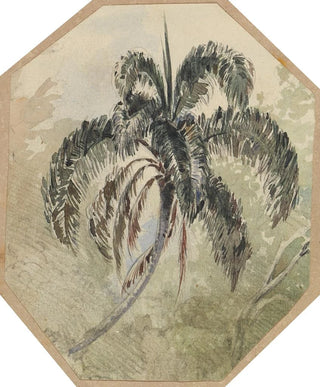Painting Study of a Palm Tree in a Jungle - Ferdinand Keller | Art print


View from behind

Frame (optional)
In the vibrant world of art, some works manage to capture the very essence of nature with rare intensity. "Study of a palm tree in a jungle" by Ferdinand Keller is one such creation. This piece, which belongs to the Romantic landscape movement, transports the viewer to the heart of a lush jungle where the vegetation flourishes in harmonious dance. Keller, with his keen eye and attention to detail, invites us to explore the mysteries of a wild world, where every leaf, every shadow tells a story. The light filtering through the foliage evokes an almost magical atmosphere, giving life to a painting that seems to breathe and vibrate in rhythm with nature.
Style and uniqueness of the work
Keller's work stands out for its meticulous approach and sharp sense of observation. In "Study of a palm tree in a jungle," he manages to make each element alive, each texture palpable. The way he plays with shades of green and light creates a striking depth, allowing the viewer to almost feel the humidity in the air and the whisper of the leaves. His style, both realistic and poetic, demonstrates technical mastery that transcends simple representation. Every brushstroke is an invitation to dive into this jungle, to discover its hidden secrets. The piece does not merely depict a palm tree; it evokes an entire ecosystem, vibrant with energy and life, where nature expresses itself in all its splendor.
The artist and his influence
Ferdinand Keller, a Swiss-born artist, is often recognized for his ability to merge meticulous observation with artistic sensitivity. His career is marked by a deep fascination with nature, reflected in his works. Influenced by the great masters of landscape painting, Keller developed a style that is uniquely his own, combining realism and romanticism. His travels around the world, especially in tropical regions, enriched his visual and emotional repertoire. Through his paintings, he invites the viewer to a serene contemplation, a communion with nature. His influence extends beyond his era, inspiring many contemporary artists to

Matte finish

View from behind

Frame (optional)
In the vibrant world of art, some works manage to capture the very essence of nature with rare intensity. "Study of a palm tree in a jungle" by Ferdinand Keller is one such creation. This piece, which belongs to the Romantic landscape movement, transports the viewer to the heart of a lush jungle where the vegetation flourishes in harmonious dance. Keller, with his keen eye and attention to detail, invites us to explore the mysteries of a wild world, where every leaf, every shadow tells a story. The light filtering through the foliage evokes an almost magical atmosphere, giving life to a painting that seems to breathe and vibrate in rhythm with nature.
Style and uniqueness of the work
Keller's work stands out for its meticulous approach and sharp sense of observation. In "Study of a palm tree in a jungle," he manages to make each element alive, each texture palpable. The way he plays with shades of green and light creates a striking depth, allowing the viewer to almost feel the humidity in the air and the whisper of the leaves. His style, both realistic and poetic, demonstrates technical mastery that transcends simple representation. Every brushstroke is an invitation to dive into this jungle, to discover its hidden secrets. The piece does not merely depict a palm tree; it evokes an entire ecosystem, vibrant with energy and life, where nature expresses itself in all its splendor.
The artist and his influence
Ferdinand Keller, a Swiss-born artist, is often recognized for his ability to merge meticulous observation with artistic sensitivity. His career is marked by a deep fascination with nature, reflected in his works. Influenced by the great masters of landscape painting, Keller developed a style that is uniquely his own, combining realism and romanticism. His travels around the world, especially in tropical regions, enriched his visual and emotional repertoire. Through his paintings, he invites the viewer to a serene contemplation, a communion with nature. His influence extends beyond his era, inspiring many contemporary artists to
12,34 €






